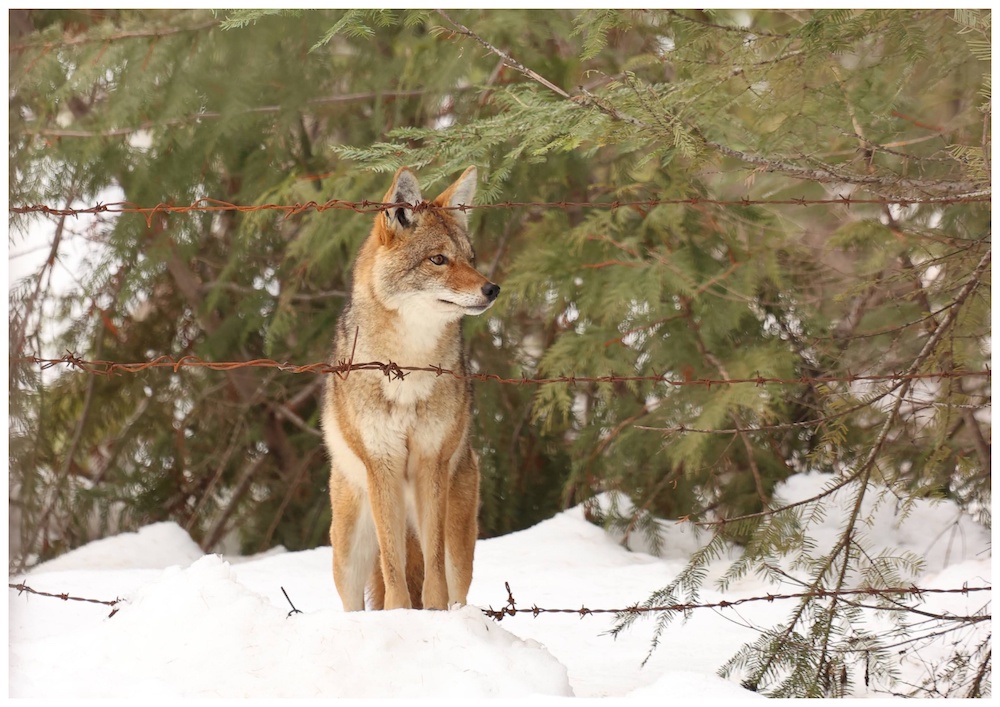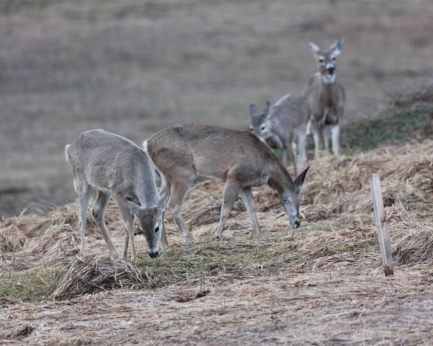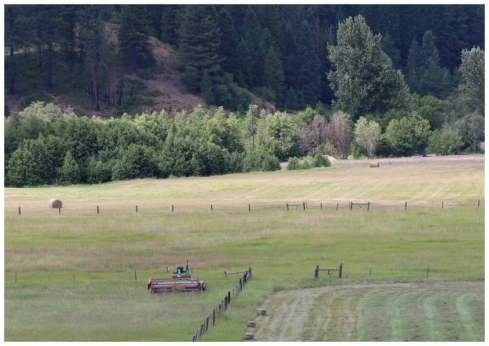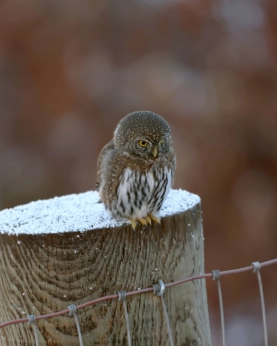I’m a Farmer Who’s Learned to Coexist with Wildlife. Here’s How You Can, Too.
Balancing agricultural productivity with the needs of wildlife can be a steep learning curve. But when it’s done right, everyone benefits.
I’m a Farmer Who’s Learned to Coexist with Wildlife. Here’s How You Can, Too.
Balancing agricultural productivity with the needs of wildlife can be a steep learning curve. But when it’s done right, everyone benefits.

Coyotes can benefit farmers by eating gophers, ground squirrels, and other rodent pests.by Jillian Garrett.
I stared at the missing plant with a sinking feeling in the pit of my stomach. The previous evening, when I had closed up the greenhouse for the night, there had been a perfect row of beautiful young pepper plants just getting ready to flower. These plants comprised one of my most lucrative farm crops, and I was excited to bring fresh peppers to the market later that season. This morning, however, there was a very obvious gap in the row. I was momentarily confused as I tried to figure out how a plant could suddenly vanish overnight. Closer inspection revealed a telltale burrow hole and tunnel. I muttered the dirty word: gopher.
Just about every farmer will tell you that dealing with wildlife is a frustrating balancing act. While most people love wild animals and want to see them exist in healthy numbers on the landscape, farmers don’t necessarily want to see those animals enjoying their hard-earned agricultural crops. Yet, as the world becomes increasingly urbanized, more and more wildlife habitat is being taken away and turned into housing developments or converted into farmland.
The future of healthy wildlife populations may partly depend on our ability to learn how to peacefully coexist with them in close quarters, and this is especially true with farming. Farmers can be immensely important allies for wildlife, with agricultural land creating vital havens of habitat. The question then becomes: How can farmers balance the need for wildlife to live on the landscape with the necessity of producing economically valuable crops?
I’ve been a rural resident and a regenerative farmer for nearly two decades, currently operating an 81-acre farm in a remote corner of northeast Washington State. During that time, most of my energy has been devoted to learning how to peacefully coexist with wildlife both on and around my property. That is not to say that the path to peaceful coexistence has been smooth. What I can tell you is that it has been enlightening—and the health of my farm has been so much the better for it.

While the farmer in me may have a difficult time admitting that creatures such as gophers possess anything other than evil intentions in their hearts, deep down I understand that they—along with the other wild animals—all have an important role to play in maintaining a balanced ecosystem. What is imperative to realize is just how much of that also translates to the overall health of the farm: Wildlife biodiversity is far more significant than many people (farmers included) appreciate.
Most of us already have some understanding of the importance of biodiversity on our property, at least from the perspective of beneficial insects and songbirds. Over the years, I’ve enjoyed installing Audubon-approved nesting boxes around my gardens to increase the populations of swallows that visit each year. They have made an enormous dent in the number of mosquitoes and biting flies that plague me and my livestock during the summer. This is a simple solution for increasing bird biodiversity, but what about when it comes to the larger animals?
Welcoming birds and bugs onto your land is easy in comparison with wildlife such as deer, elk or even predators such as coyotes. For help on this topic, I turned to my local Washington Department of Fish and Wildlife office, where I spoke to Reagan Harris, a wildlife conflict specialist who assists rural residents and farmers in learning how to coexist with wildlife on their property.
According to Harris, hedgerows are one of the best ways to increase wildlife biodiversity and habitat as well as direct animal movements away from valuable crops. Hedgerows don’t have to take up a great deal of space either: They can be something as simple as a 20-foot-wide row of shrubs or trees that run along a fence line or a riparian area. Hedgerows can also greatly benefit farmers by serving as erosion control on stream banks or as windbreaks for fields. These hedgerows not only help to create important areas of food and cover for a wide range of birds and other animals, but they also maintain critical travel corridors that help wildlife to move from one section of habitat to another.

On my own farm, I have incorporated large sections of hedgerows along creeks and strategic fence lines that surround my hay fields. These hedgerows mostly consist of native shrubs that grow well on my property_hawthorn, serviceberry, chokecherry, etc. Over the years, I have learned the real trick with hedgerows is to utilize plants that provide food as well as cover, ensuring that creatures such as deer are more occupied eating hawthorn berries and leaves than they are in my hay crops. I have observed the hedgerows on my farm providing food and habitat for a wide range of wildlife, from cottontail rabbits and ruffed grouse to black bears and mountain lions.
While hedgerows help direct the flow of wildlife traffic away from agricultural land, Harris still recommends that farmers fence off their most valuable crops whenever possible to prevent conflict. Fencing doesn’t need to be permanent, and there are many ways of utilizing temporary fencing during the growing season. The important part is to make any long-term fencing as wildlife friendly as possible, especially when enclosing large sections of land.
A good place to start is to spend time observing wildlife movement patterns on a property before beginning fencing projects. According to the Montana Department of Fish, Wildlife and Parks’s helpful guide on building fences with wildlife in mind (PDF), which I have often utilized in my own fencing projects, this helps prevent the closing off of important travel or seasonal migration corridors. That means that animals are less likely to jump over, damage or become entangled in fencing, which, in addition to preventing wildlife mortality, also saves landowners the hassle of costly and time-consuming fencing repairs. A quick and easy fencing solution that Harris recommends for farmers and rural landowners is called lay-down fencing, which is essentially a section of fence that can be laid on the ground when not in use. This allows wildlife to pass through a field when the area is not in production for crops or being used for livestock.
Learning ways to direct animal traffic away from valuable crops is an important part of the solution for peaceful coexistence, but that doesn’t mean that farmers and wildlife can’t work together to create a mutually beneficial relationship. An easy way for farmers to do this is by allowing wildlife access to recently harvested or mowed fields. Hay (or grain) stubble provides excellent forage for wildlife, especially songbirds and gamebird populations, which, in turn, can help farmers by devouring insect pests that plague crops.
One of the many ways I have learned to incorporate this on my own farm is by simply cutting my hay fields a little later in the season to provide crucial habitat and cover for wild turkey poults, helping to keep them safe from predators. Later in the season, once the hay fields are cut, these same turkeys provide welcome assistance in keeping the grasshopper population down (which is hugely beneficial to the health and aesthetics of my vegetable crops). In this way, the wild turkeys and I have figured out how to create a symbiotic relationship where we both come out winners.
Even something as simple as putting up owl boxes to encourage the presence of owls, which, in turn, eat rodent pests, can be hugely beneficial to farmers and their crops. Owl boxes are something that I have started to incorporate on my own farm, and it has been very helpful in controlling the gophers that plague me every year. There has still been a bit of a learning curve though: At first, the owl boxes were not as successful in controlling gophers as I had first hoped. Then I realized that my outside greenhouse light, which automatically turned on at dusk, was negatively impacting the ability of the owls to hunt in the dark. Once I started keeping that bright light off at night, the gopher population began decreasing as the owls were better able to hunt in my gardens. As a result, I was able to enjoy the starry skies each evening as well as the peace that comes from knowing my pepper plants were being protected by these feathered farm friends.

Learning to live with wildlife also means learning to live with natural predators on the landscape, especially in rural areas where populations of creatures such as rodents and rabbits can be high. While smaller predators such as foxes and coyotes can be beneficial in helping to control everything from gophers to ground squirrels, they can also present a problem for farmers with livestock. Here, Harris recommends a good nighttime shelter to keep poultry and small livestock, such as sheep and goats, safe from predators. She also suggests using hot wire fencing for any livestock pastures, making sure that the fencing is offset from areas of brush or thick timber from which a predator might be able to ambush.
I have implemented these suggestions on my own farm and, as a result, have been able to enjoy the perks of wild predators with minimal conflict. As a final suggestion for living with predators, Harris suggests incorporating livestock guardian dogs as another excellent option for mitigating conflict, helping to protect domestic animals while still allowing wild ones to exist on the landscape.
At the end of the day, every farm is different, requiring customized and sometimes creative solutions for living with wildlife. What works for my farm may not work for yours, nor is every attempt to coexist with wildlife always successful. The important point here is the need to try, especially as vital habitat continues to vanish in the onslaught of increasing human populations and development. Farms are in a unique position to help, as well as reap some of the potential benefits, by providing substitute habitat and maintaining essential travel corridors for wild animals—making farmers important allies to the wild creatures that continue to call these places home.
Follow us
This work is licensed under a Creative Commons Attribution-NoDerivatives 4.0 International License.
Want to republish a Modern Farmer story?
We are happy for Modern Farmer stories to be shared, and encourage you to republish our articles for your audience. When doing so, we ask that you follow these guidelines:
Please credit us and our writers
For the author byline, please use “Author Name, Modern Farmer.” At the top of our stories, if on the web, please include this text and link: “This story was originally published by Modern Farmer.”
Please make sure to include a link back to either our home page or the article URL.
At the bottom of the story, please include the following text:
“Modern Farmer is a nonprofit initiative dedicated to raising awareness and catalyzing action at the intersection of food, agriculture, and society. Read more at <link>Modern Farmer</link>.”
Use our widget
We’d like to be able to track our stories, so we ask that if you republish our content, you do so using our widget (located on the left hand side of the article). The HTML code has a built-in tracker that tells us the data and domain where the story was published, as well as view counts.
Check the image requirements
It’s your responsibility to confirm you're licensed to republish images in our articles. Some images, such as those from commercial providers, don't allow their images to be republished without permission or payment. Copyright terms are generally listed in the image caption and attribution. You are welcome to omit our images or substitute with your own. Charts and interactive graphics follow the same rules.
Don’t change too much. Or, ask us first.
Articles must be republished in their entirety. It’s okay to change references to time (“today” to “yesterday”) or location (“Iowa City, IA” to “here”). But please keep everything else the same.
If you feel strongly that a more material edit needs to be made, get in touch with us at [email protected]. We’re happy to discuss it with the original author, but we must have prior approval for changes before publication.
Special cases
Extracts. You may run the first few lines or paragraphs of the article and then say: “Read the full article at Modern Farmer” with a link back to the original article.
Quotes. You may quote authors provided you include a link back to the article URL.
Translations. These require writer approval. To inquire about translation of a Modern Farmer article, contact us at [email protected]
Signed consent / copyright release forms. These are not required, provided you are following these guidelines.
Print. Articles can be republished in print under these same rules, with the exception that you do not need to include the links.
Tag us
When sharing the story on social media, please tag us using the following: - Twitter (@ModFarm) - Facebook (@ModernFarmerMedia) - Instagram (@modfarm)
Use our content respectfully
Modern Farmer is a nonprofit and as such we share our content for free and in good faith in order to reach new audiences. Respectfully,
No selling ads against our stories. It’s okay to put our stories on pages with ads.
Don’t republish our material wholesale, or automatically; you need to select stories to be republished individually.
You have no rights to sell, license, syndicate, or otherwise represent yourself as the authorized owner of our material to any third parties. This means that you cannot actively publish or submit our work for syndication to third party platforms or apps like Apple News or Google News. We understand that publishers cannot fully control when certain third parties automatically summarize or crawl content from publishers’ own sites.
Keep in touch
We want to hear from you if you love Modern Farmer content, have a collaboration idea, or anything else to share. As a nonprofit outlet, we work in service of our community and are always open to comments, feedback, and ideas. Contact us at [email protected].by Jillian Garrett, Modern Farmer
February 7, 2024
Modern Farmer Weekly
Solutions Hub
Innovations, ideas and inspiration. Actionable solutions for a resilient food system.
ExploreExplore other topics
Share With Us
We want to hear from Modern Farmer readers who have thoughtful commentary, actionable solutions, or helpful ideas to share.
SubmitNecessary cookies are absolutely essential for the website to function properly. This category only includes cookies that ensures basic functionalities and security features of the website. These cookies do not store any personal information.
Any cookies that may not be particularly necessary for the website to function and are used specifically to collect user personal data via analytics, ads, other embedded contents are termed as non-necessary cookies.
Excellent article- so much practical common sense, I hope many more farmers and landowners get to read your compassionate essay.
So glad there are farmers like you on the land. Thank you!!
A great, informative article. Thank you
Good article to meet the demands of the day. Co-existence is very much desired in th present circumstance.